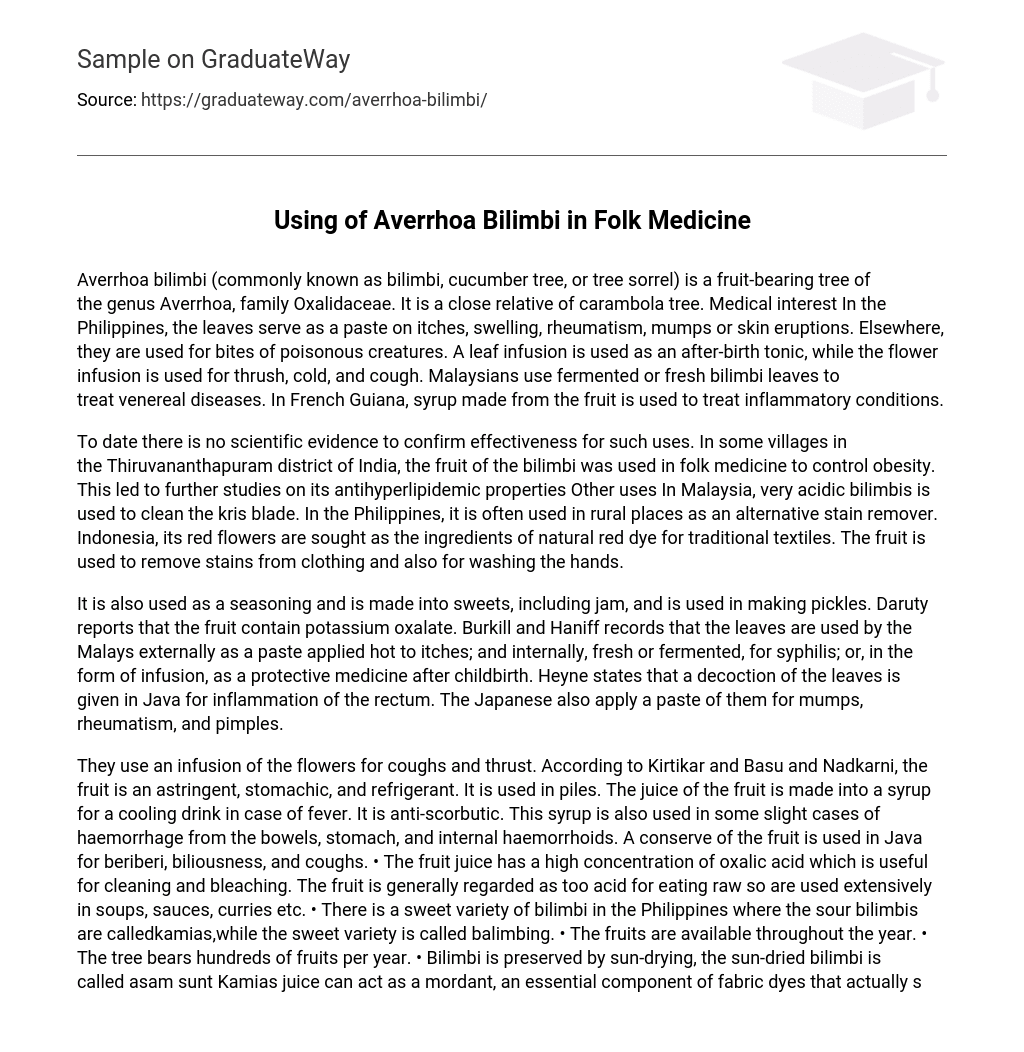Averrhoa bilimbi, commonly known as bilimbi, cucumber tree, or tree sorrel, is a fruit-bearing tree of the genus Averrhoa in the family Oxalidaceae. It is a close relative of the carambola tree.
Medical interest:
- In the Philippines, the leaves serve as a paste for itches, swelling, rheumatism, mumps or skin eruptions. They are also used for bites from poisonous creatures.
- A leaf infusion is used as an after-birth tonic while the flower infusion is used for thrush, colds and coughs.
- Malaysians use fermented or fresh bilimbi leaves to treat venereal diseases.
- In French Guiana syrup made from the fruit is used to treat inflammatory conditions.
Currently, there is no scientific evidence confirming the effectiveness of bilimbi for any specific use. However, in some villages located in the Thiruvananthapuram district of India, the fruit has been used in folk medicine to control obesity. This usage prompted further studies on its antihyperlipidemic properties.
Additionally, in Malaysia, the highly acidic nature of bilimbis makes them useful for cleaning kris blades. In rural areas of the Philippines, they are often used as an alternative stain remover. In Indonesia, people seek out its red flowers as a natural ingredient for traditional textile dyeing. The fruit can also be utilized to remove stains from clothing and wash hands.
It is also used as a seasoning and made into sweets, including jam, and pickles. According to Daruty, the fruit contains potassium oxalate. Burkill and Haniff report that Malays use the leaves externally as a hot paste for itches; internally, fresh or fermented, for syphilis; or in infusion form as a protective medicine after childbirth. Heyne states that in Java, a decoction of the leaves is given for inflammation of the rectum. The Japanese apply a paste of them for mumps, rheumatism, and pimples.
They use an infusion of the flowers for coughs and thirst. According to Kirtikar and Basu and Nadkarni, the fruit is astringent, stomachic, and refrigerant. It is used in treating piles. The juice of the fruit is made into a syrup for a cooling drink in case of fever as it has anti-scorbutic properties. This syrup is also used to treat slight cases of hemorrhage from the bowels, stomach, and internal hemorrhoids. In Java, a conserve made from the fruit is used to treat beriberi, biliousness, and coughs.
The fruit juice has a high concentration of oxalic acid, which is useful for cleaning and bleaching. The fruit is generally regarded as too acidic for eating raw, so it is used extensively in soups, sauces, curries, etc. In the Philippines, there is a sweet variety of bilimbi called balimbing while the sour bilimbis are called kamias. The fruits are available throughout the year as the tree bears hundreds of fruits per year.
Bilimbi is preserved by sun-drying. The sun-dried bilimbi is called asam sunt. Kamias juice can act as a mordant, which is an essential component of fabric dyes that sets the color onto the fabric. In Southeast Asia, Kamias juice is traditionally used in orange dyes on silk fabrics.





